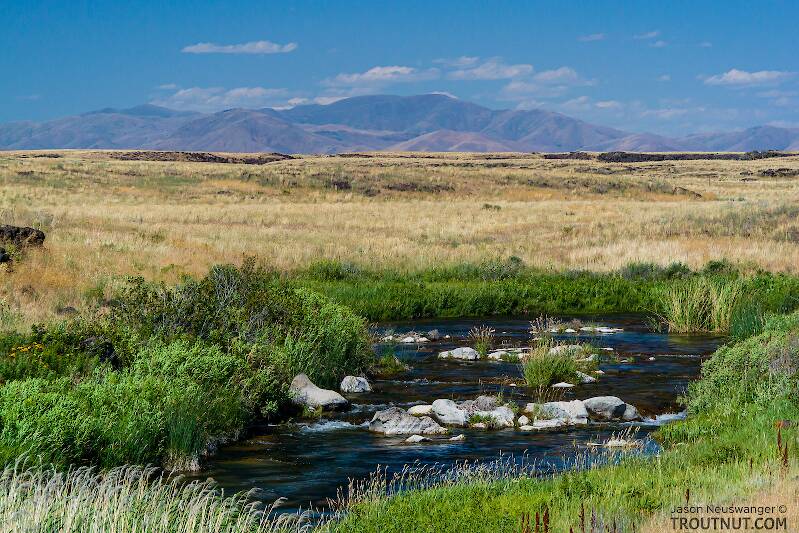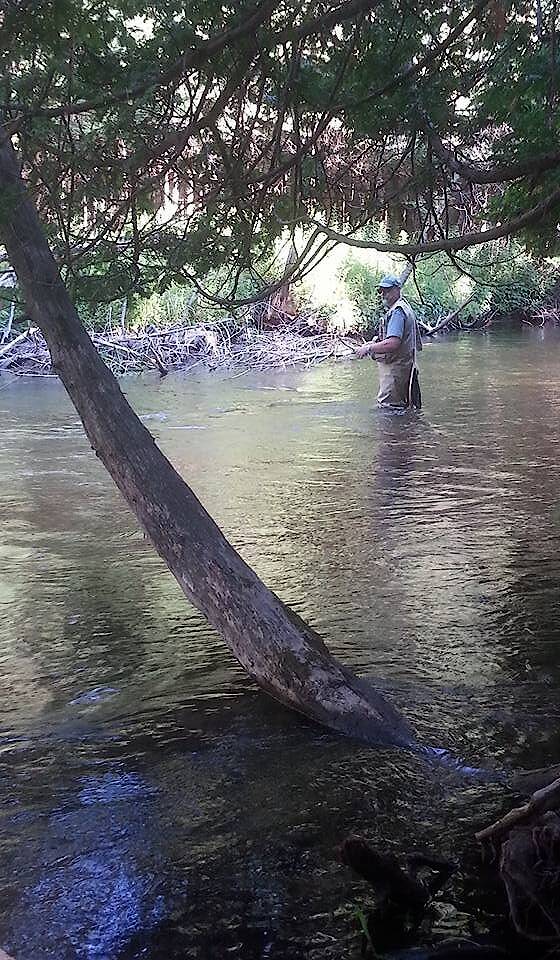
Hex Mayflies
Hexagenia limbata
The famous nocturnal Hex hatch of the Midwest (and a few other lucky locations) stirs to the surface mythically large brown trout that only touch streamers for the rest of the year.
Featured on the forum

Troutnut is a project started in 2003 by salmonid ecologist Jason "Troutnut" Neuswanger to help anglers and
fly tyers unabashedly embrace the entomological side of the sport. Learn more about Troutnut or
support the project for an enhanced experience here.
Roguerat on Feb 7, 2015February 7th, 2015, 12:09 pm EST
Off on a(nother) tying tangent here, but I've watched a couple videos on Klinkhamers to get the basics but I'm striking out on a source for the floating poly yarn used for the wing-post. The floating feature seems integral to the intent of the fly- to hang in the surface-film with its 'butt' down more like an emerger. Any advice or sources would be great.
That, and is the real Klinkhamer hook required- I was considering a scud hook as a stand-in, if the curve and eye geometry was close enough.
40 degrees in W Mich this afternoon and a day closer to the season opener...
Roguerat
I Peter 5:7 'Cast your cares upon Him...'
That, and is the real Klinkhamer hook required- I was considering a scud hook as a stand-in, if the curve and eye geometry was close enough.
40 degrees in W Mich this afternoon and a day closer to the season opener...
Roguerat
I Peter 5:7 'Cast your cares upon Him...'
Wbranch on Feb 7, 2015February 7th, 2015, 4:57 pm EST
Roguerat,
Here is a link; http://www.caddisflyshop.com/poly-pro-floating-yarn.html
It is $2.00 per card and comes in about five colors.
Here is a link; http://www.caddisflyshop.com/poly-pro-floating-yarn.html
It is $2.00 per card and comes in about five colors.
Catskill fly fisher for fifty-five years.
Martinlf on Feb 9, 2015February 9th, 2015, 8:29 am EST
I like the Daiichi 1130 (and 1120 for larger sizes) for Klinkhamers. In my experience they hook and hold well.
"He spread them a yard and a half. 'And every one that got away is this big.'"
--Fred Chappell
--Fred Chappell
Roguerat on Feb 9, 2015February 9th, 2015, 9:35 am EST
Guys, thanks for the tips on this pattern. I was looking for the floating poly yarn on Craft Store sites, didn't know this was a tying-specific material.
That and the hooks are a good reason to head to the local fly-shop soon.
That and the hooks are a good reason to head to the local fly-shop soon.
Planettrout on Feb 10, 2015February 10th, 2015, 7:05 am EST
Here are four different sources for Poly Yarn:
http://hareline.com/pf.html
http://www.bobmarriottsflyfishingstore.com/fly-tying-materials/chenilleyarnfloss/yarn/wapsi-polypropylene-floating-yarn
https://spiritriver.com/materials/poly-yarn
http://www.cascadecrest.com/Poly-Yarn-p/242.htm
Hans only endorses the Daiichi 1160 and 1167 hooks for his Klinks...
PT/TB
http://hareline.com/pf.html
http://www.bobmarriottsflyfishingstore.com/fly-tying-materials/chenilleyarnfloss/yarn/wapsi-polypropylene-floating-yarn
https://spiritriver.com/materials/poly-yarn
http://www.cascadecrest.com/Poly-Yarn-p/242.htm
Hans only endorses the Daiichi 1160 and 1167 hooks for his Klinks...
PT/TB
Daughter to Father: "How many arms do you have, how many fly rods do you need?"
http://planettrout.wordpress.com/
http://planettrout.wordpress.com/
Oldredbarn on Feb 10, 2015February 10th, 2015, 1:06 pm EST
Can use Hi-Viz or EP Fibers...It's not the post that floats the fly its the parachute hackle. The post is so you can see the thing.
Yes you can use a scud hook...In Oliver's Edwards book that introduced the fly to everyone, he used a lighter and bent a partridge hook...The model number escapes me.
Spence
Yes you can use a scud hook...In Oliver's Edwards book that introduced the fly to everyone, he used a lighter and bent a partridge hook...The model number escapes me.
Spence
"Even when my best efforts fail it's a satisfying challenge, and that, after all, is the essence of fly fishing." -Chauncy Lively
"Envy not the man who lives beside the river, but the man the river flows through." Joseph T Heywood
"Envy not the man who lives beside the river, but the man the river flows through." Joseph T Heywood
TNEAL on Feb 11, 2015February 11th, 2015, 3:00 am EST
Nice comment about the purpose of the parachute hackle. posts stick straight up unlike the natural's wings. I believe the effectiveness of properly tied parachutes can be attributed to their imitating both emergers and floating nymphs; both of which are abundant especially in heavy emergences. That's why I believe the "tails" on parachutes should be a bit heavier than you would normally make.
Oldredbarn on Feb 11, 2015February 11th, 2015, 10:37 am EST
posts stick straight up unlike the natural's wings
Tim. Have you seen Ed McCoy's fly on Hawkin's web site? He ties in the post with a slant back like the natural mayfly wing. Ties it in like you might an elk-hair caddis. He leaves the butt-ends on and ties on a hackle and winds it beneth the wing and the butt ends...Ties it off and trims the front butt-ends off low...
We tied some up the other evening at my winter tying group. I fished it last June with Ed and we did well with it during Brown Drakes. I got a 22 and my buddy hooked a two-footer.
Now...You and I know that when the fish are up like they were, probably any drake pattern would of worked, but it floats well.
The Klinkhammer was designed as a caddis emerger originally. I tie a version on a scud hook with a natural goose/turkey biot body, gray post and dark dun parachute hackle...Can't see it, but when the early season Baetis and Little Mahoganies are about they love it...They have never told me what they take it for, but there are those dark little caddis about, around that same time...Maybe they think they are caddis.
My fishing buddy and I used to subscribe to Trout and Salmon from Great Britian 25 years or so ago...We first saw the fly then and it was a top-secret fly for awhile until the word got out. My buddy said that since I am Dutch and Hans is Dutch, I needed a "dutch" fly in my boxes...A small all black with griz hackle makes a great emerging midge on stillwaters.
Spence
"Even when my best efforts fail it's a satisfying challenge, and that, after all, is the essence of fly fishing." -Chauncy Lively
"Envy not the man who lives beside the river, but the man the river flows through." Joseph T Heywood
"Envy not the man who lives beside the river, but the man the river flows through." Joseph T Heywood
TNEAL on Feb 11, 2015February 11th, 2015, 3:26 pm EST
Haven't seen it but will take a look. Sounds a bit complicated for an old timer like myself. I prefer flies like the North Branch Drake; it imitates all caddis emergers; tied with almost all (gasp) deer hair. Same clump of hair makes the body and trailing shuck. Short sprig of deer hair for a partly emerged wing and a bit of hackle at the head. vary the shade of deer hair, thread color, and hackle as well as hook size and you can match any caddis or stone in the country. Styles are so much easier to remember than specific patterns.
Martinlf on Feb 11, 2015February 11th, 2015, 3:35 pm EST
I tie a version on a scud hook with a natural goose/turkey biot body, gray post and dark dun parachute hackle...Can't see it, but when the early season Baetis and Little Mahoganies are about they love it...
Yes. Try one with a red-orange or pink post one day, Spence. The highly pressured Spring Creek trout don't generally seem to mind them (though I do trim these posts somewhat short), and in intense glare one can find the fly after it hits the water. Black posts can work too, but I am partial to the fire orange EP Fibers, which are for my eyes just about the easiest to pick out in all kinds of glare.
He ties in the post with a slant back like the natural mayfly wing. Ties it in like you might an elk-hair caddis. He leaves the butt-ends on and ties on a hackle and winds it beneth the wing and the butt ends...Ties it off and trims the front butt-ends off low...
Interesting. I've seen some caddis tied this way also.
"He spread them a yard and a half. 'And every one that got away is this big.'"
--Fred Chappell
--Fred Chappell
Wbranch on Feb 11, 2015February 11th, 2015, 4:32 pm EST
posts stick straight up unlike the natural's wings
Don't most of the wings we tie on dry flies stick straight up?
- Divided wing is vertical
- Compara-dun is vertical
- Turkey flats are vertical
How many commercially available dry fly wings are tied in on an angle or have cut, or burned, wing profiles like the natural's?
Catskill fly fisher for fifty-five years.
Quick Reply
Related Discussions
Topic
Replies
Last Reply
Re: Big Green River, Wisconsin, late September
In the Mayfly Species Baetis brunneicolor by Admiralb
In the Mayfly Species Baetis brunneicolor by Admiralb
1
Sep 30, 2013
by Entoman
by Entoman







